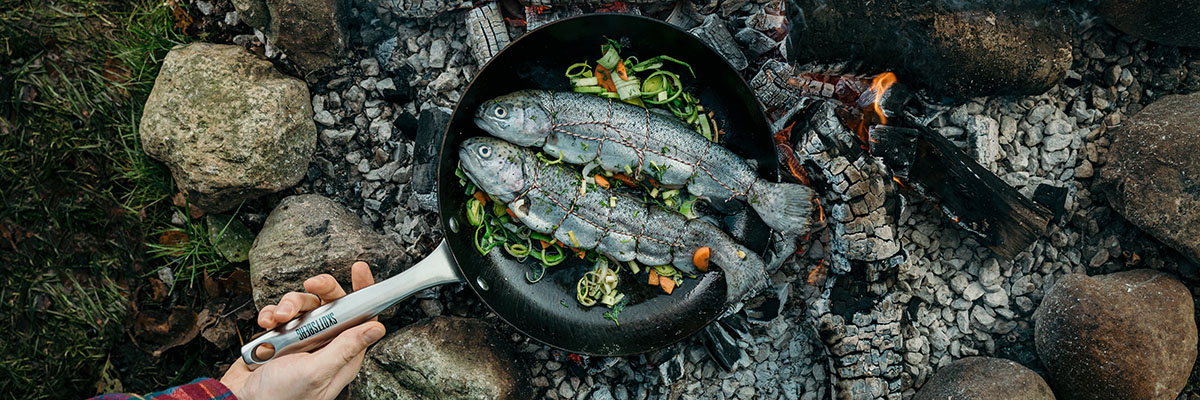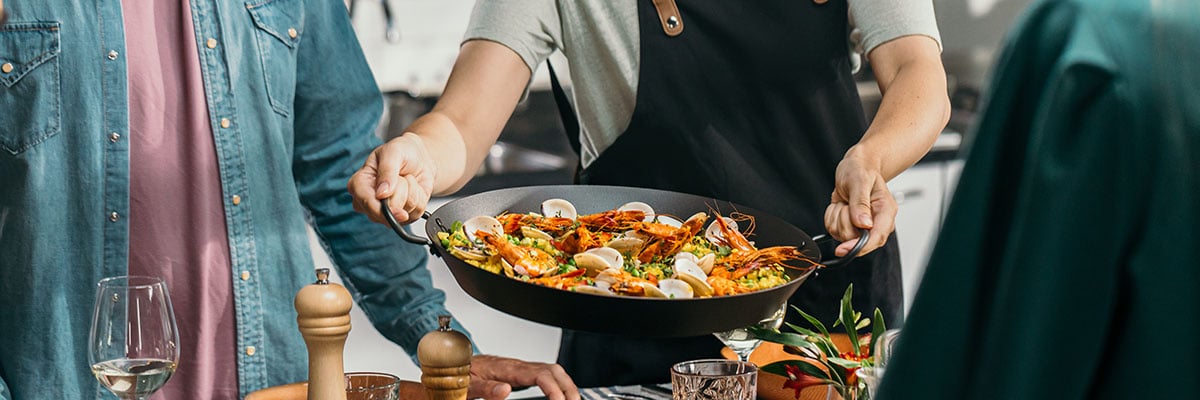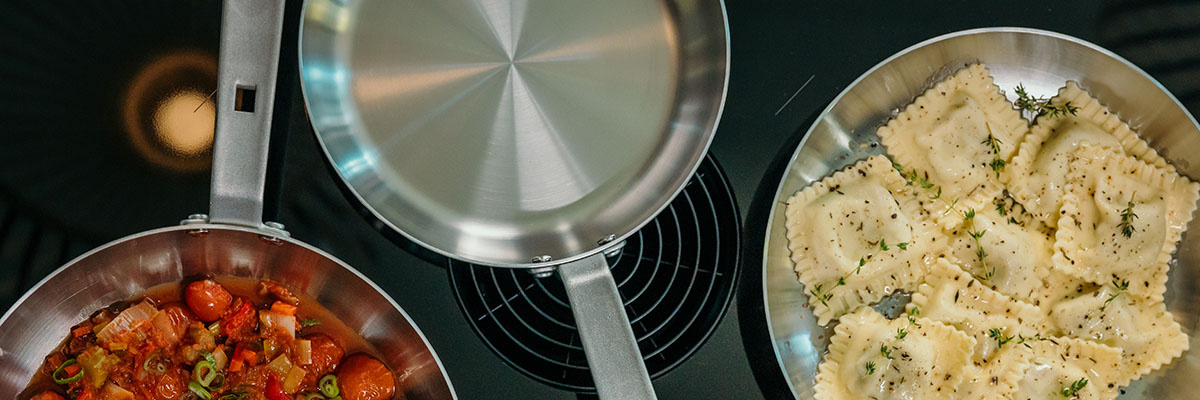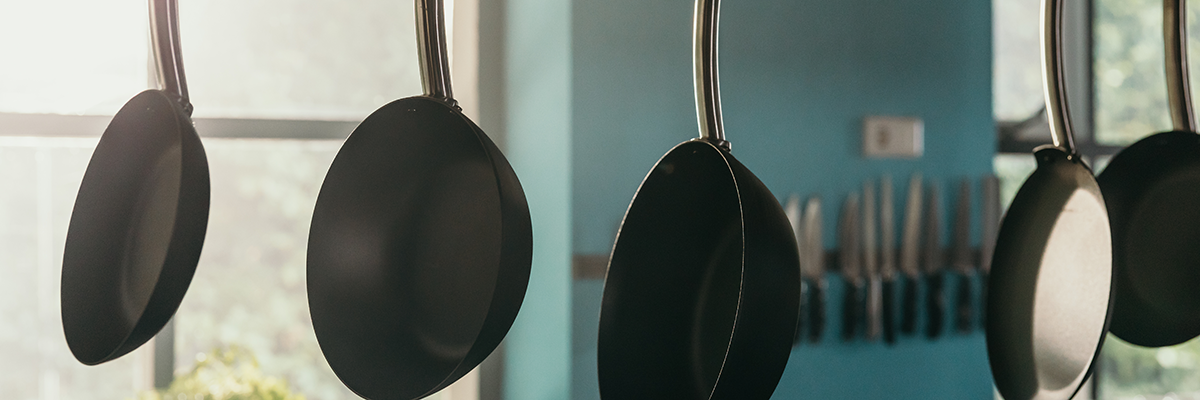When your search for a new pan starts, you are overwhelmed with terms such as ceramic, cast iron, Teflon, aluminium and so on. But which material pan best suits your needs? And why are there so many different types of materials for pans? We have created a handy overview for you with explanations for each material pan. So take advantage of it.
Before we get started, it is useful to know the difference between a synthetic and natural non-stick coating. The term "non-stick coating," of course, says it all: it is a coating that prevents your food from sticking in a pan. A synthetic non-stick coating contains chemicals, such as PFAO, which are released into the pan when damaged and worn down. And believe me, you would rather not have these chemicals in your food. A natural non-stick coating consists of a vegetable oil. Thus, if damaged, no toxic substances will be released. Also, you can provide this natural non-stick coating with a new protective layer each time by season in the pan.

Cast iron pans are a popular choice. Why? Cast iron has the property of retaining and distributing heat evenly. A cast iron pan normally does not have a non-stick coating. You create this layer yourself by searing the pan with a natural oil. This natural non-stick coating means a cast iron pan will, therefore, last a lifetime if properly used and maintained.
A major disadvantage of cast iron pans is their weight. Traditional cast iron is heavy, making your cooking experience also a workout. Also, traditional cast iron takes longer to heat up but, in turn, retains heat longer.
With lightweight cast iron, you can let loose in the kitchen without getting injured. The downside of lightweight cast iron? It has more hot spots than traditional cast iron.
We stay in the pans 'without' a non-stick coating for a while. And we say 'without' because even with a carbon steel pan, you create your own natural non-stick coating with a vegetable oil. Carbon steel is a material consisting of thin sheets of steel to which no other materials are added. So you don't have to worry about ingesting foreign substances while cooking. A carbon steel pan is, therefore, completely safe for your health. So, are there no drawbacks at all? Yep. Carbon steel rusts easily if you do not store your pan in a bone-dry place, and it is also a bit heavier than, say an aluminium pan.

Stainless steel is a material widely used for pans. After all, the name says it all: it is steel that does leave stains. This makes it a durable material with low maintenance. Unlike cast iron and carbon steel pans, a stainless steel pan lacks a non-stick coating. But with a stainless steel pan there is no need to season in the pan with a vegetable oil yourself. Due to the lack of a non-stick coating, it is therefore wise to use some extra fat with protein-rich food with this pan. A major advantage of a stainless steel pan? You simply put this pan in the dishwasher after use.
As stainless steel does not conduct heat as well, these pans are often made of several layers of stainless steel as well as aluminium. These can be 3, 5 or even 7 layers (also called 3-ply, 5-ply and 7-ply) that ensure better heat dispersion.

From pans without a non-stick coating, we move to the pan with a synthetic non-stick coating. With a Teflon pan, this layer is made of PTFE. This makes it an ideal pan as food does not stick, and it is easy to clean. Teflon pans, on the other hand, can be dangerous if they overheat or if pieces of non-stick coating come off. When used normally, they are safe. But replace the pan at the slightest damage to avoid getting chemicals in your food.
Aluminium is a good conductor of heat, making it a perfect material for pans. You will find aluminium pans in two types, namely pans with raw aluminium and anodised aluminium. But despite aluminium being a good conductor of heat, studies have shown that small particles of aluminium are released during cooking. Something you'd rather not have in your food. Curious to learn more about the different types of aluminium pans and how harmful those loose particles of aluminium are to you? You can read about this in our knowledge base article.

A ceramic pan has a non-stick coating that is not made of toxic chemicals, but of a layer of ceramic. This makes a ceramic pan a lot healthier than the traditional non-stick pan. A ceramic pan will last a decent amount of time. Provided you look after it properly. Yet damage easily happens in this pan. As a result, buying a new pan is on the cards sooner than you think. Not very sustainable, then.
Marmer coating pans contain no harmful substances, so you can cook with peace of mind. These pans are often compared to ceramic pans. The difference is in the coating, which in marble coating pans resembles natural stone. Will a marble coating pan then last a lifetime? Probably not. For example, the use of metal kitchen utensils corrodes the natural stone coating, and a marble-coated pan needs to be replaced every now and then.

















